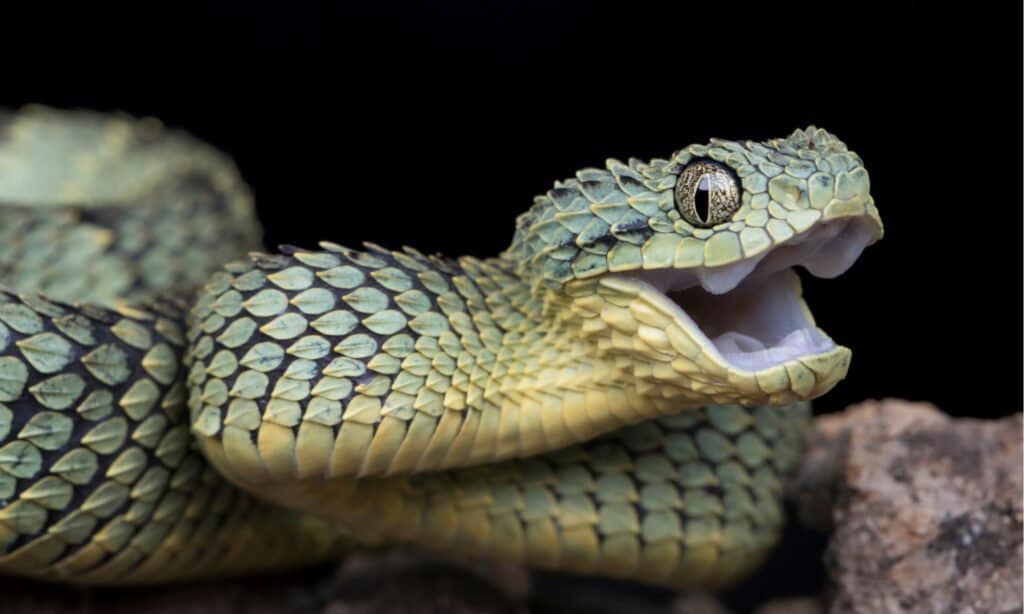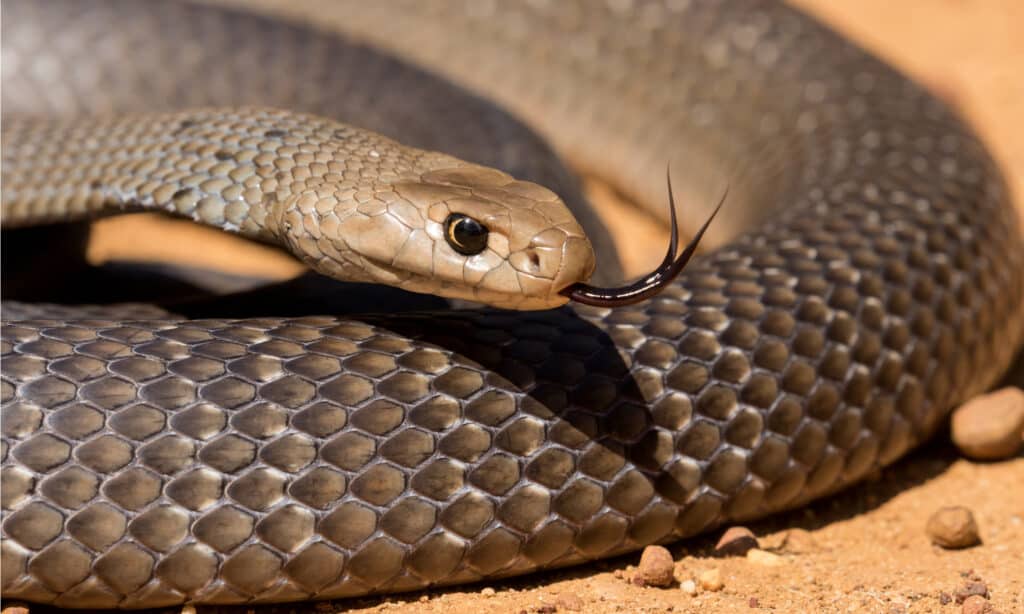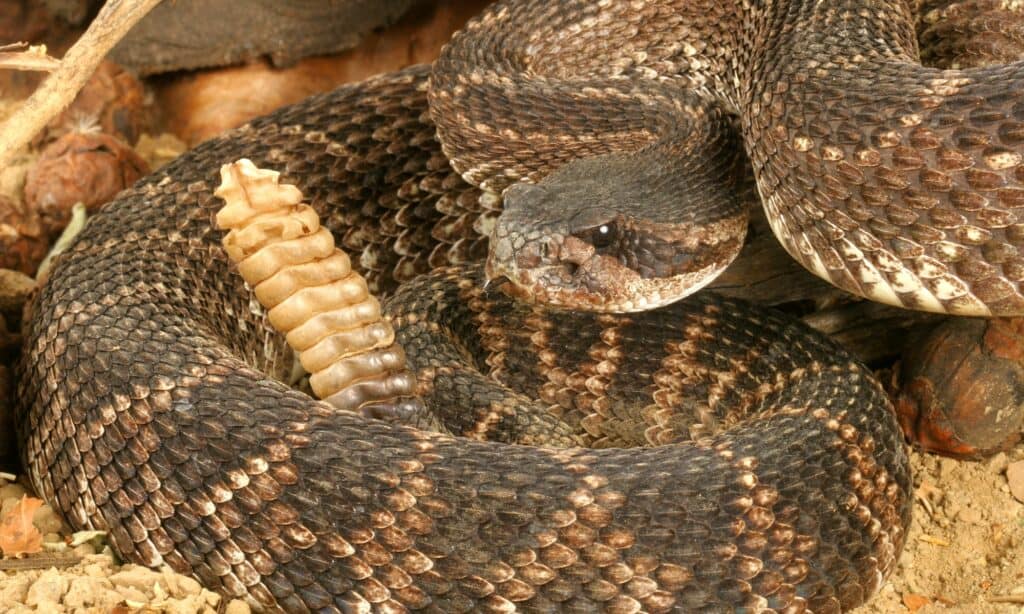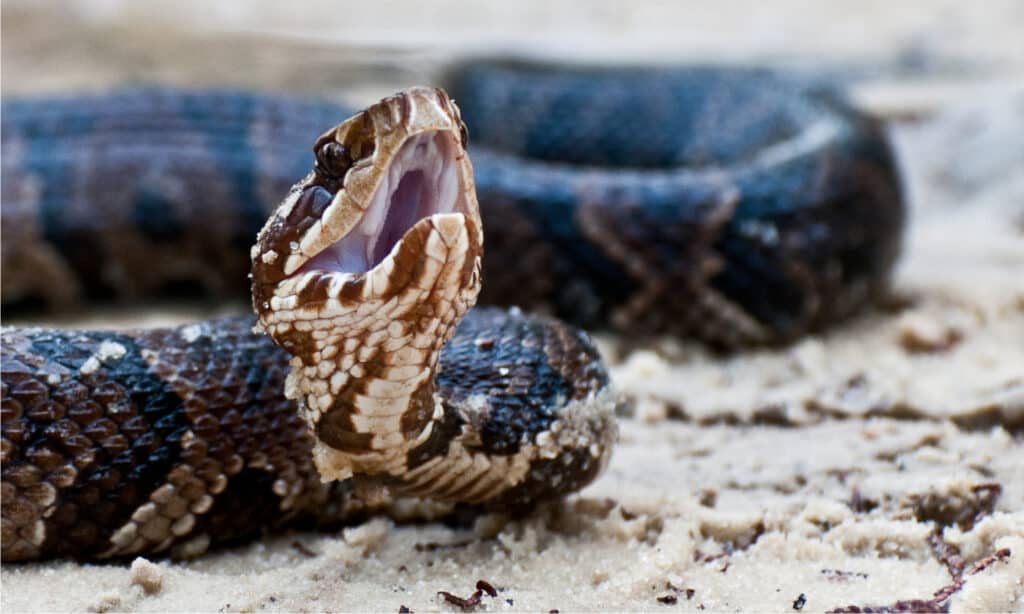Snakes are one of the most frightening and widely-feared reptiles. Since many people do not learn about snakes because of their fears, myths are often believed to be true. One such myth is that snakes smell like cucumbers. This myth is an interesting one, however, because although it is false, it has factual roots.
In this article, not only will we take a look at the snake-cucumber myth, but we will also take a look at the snake’s musk.
Let’s get started and discover the surprising smells venomous snakes in the US produce when frightened.
Do Snakes Secrete Musk?

Snakes have the ability to emit a strong-smelling musk to deter attackers.
©Mark_Kostich/Shutterstock.com
There are about 30 species of venomous snakes in the US. These snake species have various peculiar characteristics. Some of them are attacking features while others are to defend them.
One of their defense tactics is their ability to emit a strong-smelling musk to deter attackers. They emit this musk through their pair of cloacal scent glands. According to Andrew H. Price, a herpetologist working in natural resource management for Texas Parks, “each gland is enclosed by longitudinal striated muscle, and the duct leading to the cloaca is provided with a circular striated muscle sphincter…” This allows us to safely conclude that snakes secrete musk rather rapidly.
How Often Do Snakes Secrete Musk?
One of the most interesting aspects of snakes is their ability to secrete musk, a pungent odor that serves as a defense mechanism against predators or a way to mark their territory. But how often do snakes secrete musk? The answer varies depending on the species and individual snake, but most snakes will secrete musk when they feel threatened or stressed.
Some species of snakes, such as garter snakes, are known to secrete musk more readily than others. Garter snakes are relatively docile and will often release musk when handled or threatened.
It’s important to note that snakes don’t secrete musk constantly, and will only do so when they feel it’s necessary. This means that if you encounter a snake in the wild, there’s a good chance that it won’t secrete musk unless it feels threatened or stressed.
Why Do Snakes Secrete Musk?

Snakes’ ability to secrete musk is a defense mechanism.
©Ken Griffiths/Shutterstock.com
Research suggests that a snake’s ability to secrete musk is a defense mechanism. This is because snakes only secrete musk when they are distressed or have been captured. Furthermore, it is believed that female and male musks smell differently.
What Does Snake Musk Smell Like?
Different species of snakes produce musk with smells that are unique to them. However, all types of snake musk have a uniting feature; they smell horrible. The smell is often described as being similar to rotten eggs or rotten produce. Oftentimes, snakes mix their musk with feces before secreting it at attackers. In addition, not all species of snakes emit musk.
Why Does Snake Musk Smell So Bad?
Snake musk is created by the cloacal gland and is made up of various chemicals found in the gland. These chemicals are designed to be as smelling and repulsive as possible. The worst thing about snake musk is that it is infamously hard to get rid of. A single wash with soap and water will do little to help you get rid of the smell.
However, considering that the alternative defense mechanism is its venom, perhaps being sprayed with musk is getting off lightly. Here are some of the surprising and peculiar smells produced by venomous snakes in the US.
Surprising Smells Produced by Venomous Snakes in the US
Copperheads

The Copperhead’s scales are keeled, and their eyes have vertical pupils that make them resemble cat’s eyes.
©Creeping Things/Shutterstock.com
(Image Caption: According to many opinions, copperhead musk smells a bit like cucumbers.)
Copperheads are mostly found in North Carolina. They are very venomous and also secrete musk. They are considered rather aggressive as they often bite without a warning. However, it is worth noting that copperheads usually only do this when threatened.
Copperheads can grow to a maximum height of 36 inches. They are heavy snakes with triangular heads. They also have cat eyes which are called elliptical pupils. These snakes are born in amniotic sacs, and not as eggs. This means that like lizards, they are ovoviviparous.
When hunting, copperheads are quick to ambush and bite their prey. However, if they are distressed and suddenly captured, they are more likely to secrete their musk.
What Does Copperhead Musk Smell Like?
According to many opinions, copperhead musk smells a bit like cucumbers. However, it is important to note that this is purely subjective, as cucumbers usually have a pleasant smell. The copperhead’s musk is by no means pleasant. Perhaps, it would be more fitting to describe copperhead musk as similar to that of bad or spoilt cucumbers. Oftentimes, copperheads mix their musk with feces to make it smell even worse.
Rattlesnakes

The musk of the rattlesnake is often described as heavy, musky, and impossible to miss.
©iStock.com/johnaudrey
Rattlesnakes, which are recognized as pit vipers, are one of the more popular species of venomous snakes found in America. One of their distinctive features is the rattle in their tails. Their rattling tails have been associated with venom. This is why some rat snakes rattle their tails to mimic them and trick potential attackers into believing that they are venomous rattlesnakes. Rattlesnake venom contains both hemotoxins and neurotoxins.
What Does Rattlesnake Musk Smell Like?
The musk of the rattlesnake is often described as heavy, musky, and impossible to miss.
Cottonmouths/ Water Moccasins

Water moccasins produce musk with odors often compared to skunks’.
©Jay Ondreicka/Shutterstock.com
Cottonmouths are semi-aquatic snakes that are known for their venom. They have triangular heads as well as elliptical pupils and are born with brightly-colored tail tips. These tips fade to black as they age. Adult cottonmouths are colored yellowish-olive to darker shades of black and gray.
Their venom contains hemotoxins that break down blood cells and stop blood from clotting. Once the venom spreads, it will take only a short moment for the circulatory system to begin hemorrhaging. Cottonmouths also secrete musk.
What does Cottonmouths/ Water Moccasins Musk Smell Like?
Water moccasins produce musk with odors often compared to skunks’. It is especially foul and is easy to trace, so if there’s a cottonmouth in distress near you, its musk can lead you to it.
Do Snakes Smell Like Cucumber?
Snakes do not smell like cucumbers. However, some species, such as the copperhead, emit musk with an odor that is likened to spoiled cucumbers.
How to Get Rid of Snake Musk
Here are some tips on how to get rid of a snake’s musk.
- Wash multiple times: Although one wash won’t do the trick, multiple washes might fix the problem. This will suffice if you weren’t sprayed too directly. Try to wash with a washcloth or sponge but be careful not to scrub too hard.
- Metal soap: You know how regular soap doesn’t seem to be able to take away strong smells such as fish, onion, and garlic? Metal soap was designed for exactly this purpose. It eliminates strong smells.
- Vinegar: If you do not have access to metal soap, you could look to white vinegar for help. White vinegar, also known as distilled malt vinegar, will help erase the smell. It can also help clean musk-sprayed clothes.
How to Prevent a Snake from Spraying Musk
(Image Caption: The best way to prevent a snake from spraying musk is to avoid distressing it.)
The best way to avoid snakes in the summer is to stay away from their usual habitats. Investing in snake-repelling plants is also a good idea. However, if you do encounter a snake, remember that they use musk in defense. They do not usually secrete musk if they do not feel threatened.
The best way to prevent a snake from spraying musk is to avoid distressing it. Try to make the snake feel comfortable around you. If the snake feels scared and sprays musk on you despite your efforts, avoid making much of a fuss. It’ll only frighten the snake further. Remember to handle snakes with gentility and patience.
Can You Smell When a Snake is Near?

Copperhead snakes are thought to emit a scent reminiscent of cucumbers when they are angry.
©JacobLoyacano/Shutterstock.com
This may be dependent on the person, as some claim to be able to smell a nearby snake. However, snakes don’t usually have a certain smell that you are able to detect simply by being in their presence unless they are angry or feeling threatened. It is important to note that they don’t secrete odors all of the time and will only do so when necessary. Should you pick them up to smell them (which you shouldn’t), you might notice a musky, off-putting scent. This odor is secreted when they feel threatened. However, even when they secrete a scent, it may smell different to each person.
While you may not be able to always smell a snake when it is near, there are other indicators that there may be one close by. One of the best signs is if you find a shed snake skin in the vicinity. Snakes molt as they grow and leave their old skin behind, which will often appear translucent. Another indicator is slither tracks left behind. It is always best to remember that should you run into a snake in the wild, it is always best to leave it alone.
The photo featured at the top of this post is © Ken Griffiths/Shutterstock.com
Discover the "Monster" Snake 5X Bigger than an Anaconda
Every day A-Z Animals sends out some of the most incredible facts in the world from our free newsletter. Want to discover the 10 most beautiful snakes in the world, a "snake island" where you're never more than 3 feet from danger, or a "monster" snake 5X larger than an anaconda? Then sign up right now and you'll start receiving our daily newsletter absolutely free.
Thank you for reading! Have some feedback for us? Contact the AZ Animals editorial team.






